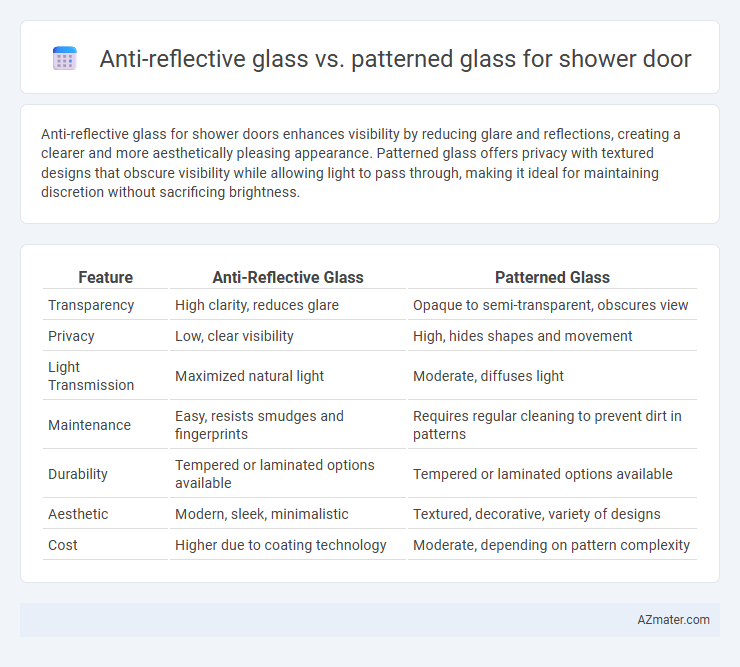Anti-reflective glass for shower doors enhances visibility by reducing glare and reflections, creating a clearer and more aesthetically pleasing appearance. Patterned glass offers privacy with textured designs that obscure visibility while allowing light to pass through, making it ideal for maintaining discretion without sacrificing brightness.
Table of Comparison
| Feature | Anti-Reflective Glass | Patterned Glass |
|---|---|---|
| Transparency | High clarity, reduces glare | Opaque to semi-transparent, obscures view |
| Privacy | Low, clear visibility | High, hides shapes and movement |
| Light Transmission | Maximized natural light | Moderate, diffuses light |
| Maintenance | Easy, resists smudges and fingerprints | Requires regular cleaning to prevent dirt in patterns |
| Durability | Tempered or laminated options available | Tempered or laminated options available |
| Aesthetic | Modern, sleek, minimalistic | Textured, decorative, variety of designs |
| Cost | Higher due to coating technology | Moderate, depending on pattern complexity |
Introduction: Purpose of Shower Door Glass
Shower door glass is designed to provide privacy, safety, and aesthetic appeal in bathroom settings by serving as a barrier that contains water while enhancing the overall decor. Anti-reflective glass offers clear visibility and reduces glare, making it ideal for creating an open, spacious look. Patterned glass, featuring textured or frosted designs, enhances privacy and adds decorative elements while diffusing light.
What is Anti-reflective Glass?
Anti-reflective glass is specially coated to minimize glare and enhance transparency, making it ideal for shower doors by providing a clear, unobstructed view. This glass significantly reduces reflections caused by lighting, improving both aesthetics and visibility in wet environments. Patterned glass, in contrast, offers privacy through textured designs but does not eliminate reflections like anti-reflective glass.
What is Patterned Glass?
Patterned glass is textured glass designed with various surface patterns to enhance privacy while allowing light to pass through, making it ideal for shower doors. Unlike anti-reflective glass, which reduces glare and improves clarity, patterned glass obscures visibility to maintain discretion without sacrificing brightness. Common patterns include rain, reed, and frosted textures that add decorative appeal and functional privacy to bathroom settings.
Clarity and Visual Appeal Comparison
Anti-reflective glass offers superior clarity by reducing glare and minimizing reflections, enhancing visibility and creating a sleek, modern look for shower doors. Patterned glass introduces texture and decorative elements that obscure direct sightlines, providing privacy while adding artistic visual appeal but sacrificing some transparency. Choosing between the two depends on prioritizing either unobstructed clarity with anti-reflective glass or unique, privacy-enhancing aesthetics with patterned glass.
Privacy Features: Which Glass Offers More?
Anti-reflective glass enhances clarity by reducing glare while offering minimal privacy, making it ideal for clear visibility in shower doors. Patterned glass features textured designs that distort vision and obscure shapes, significantly increasing privacy compared to anti-reflective options. For those prioritizing privacy in shower enclosures, patterned glass provides superior concealment without sacrificing light transmission.
Durability and Maintenance Requirements
Anti-reflective glass for shower doors offers superior durability due to its specialized coatings that resist scratches and reduce glare, enhancing long-term clarity with minimal upkeep. Patterned glass, while visually appealing, may accumulate soap scum and mineral deposits more easily in its texture, requiring more frequent cleaning to maintain transparency. Maintenance for anti-reflective glass typically involves gentle cleaning with non-abrasive agents, whereas patterned glass demands regular scrubbing to prevent buildup in the etched or embossed designs.
Cost Differences: Budget Considerations
Anti-reflective glass typically costs more than patterned glass due to advanced coatings that reduce glare and enhance clarity, making it a premium choice for shower doors. Patterned glass offers a more budget-friendly option, providing privacy and decorative appeal with lower manufacturing expenses. Homeowners should consider their specific design goals and budget constraints when choosing between the higher upfront cost of anti-reflective glass and the economical benefits of patterned glass.
Installation Process and Customization Options
Anti-reflective glass for shower doors requires precise installation to maintain its clarity and minimize glare, often involving specialized coatings that must be handled with care to avoid damage. Patterned glass offers greater customization options, as its varied textures and designs can be tailored to enhance privacy and aesthetic appeal, but may demand more intricate fitting to align patterns correctly. Both types necessitate professional installation to ensure proper sealing and durability, with anti-reflective glass favoring smooth, minimalist frames and patterned glass accommodating diverse frame styles for enhanced design flexibility.
Best Use Cases: Which Glass Fits Your Bathroom?
Anti-reflective glass is ideal for shower doors in bathrooms with limited natural light, enhancing clarity and offering a sleek, modern look by minimizing glare and reflections. Patterned glass provides increased privacy and conceals water spots and fingerprints, making it suitable for busy households or bathrooms shared by multiple users. Selecting the right glass depends on your priority for visibility versus privacy and the overall aesthetic you want to achieve in your bathroom space.
Conclusion: Choosing the Right Shower Door Glass
Anti-reflective glass offers superior clarity and reduces glare, making it an excellent choice for sleek, modern bathrooms that prioritize visibility and minimal distractions. Patterned glass provides enhanced privacy through textured designs while still allowing light to pass, ideal for those seeking style combined with discretion. Selecting the right shower door glass depends on balancing the need for transparency versus privacy, with anti-reflective glass suited for open, bright spaces and patterned glass preferred for more intimate environments.

Infographic: Anti-reflective glass vs Patterned glass for Shower door
 azmater.com
azmater.com